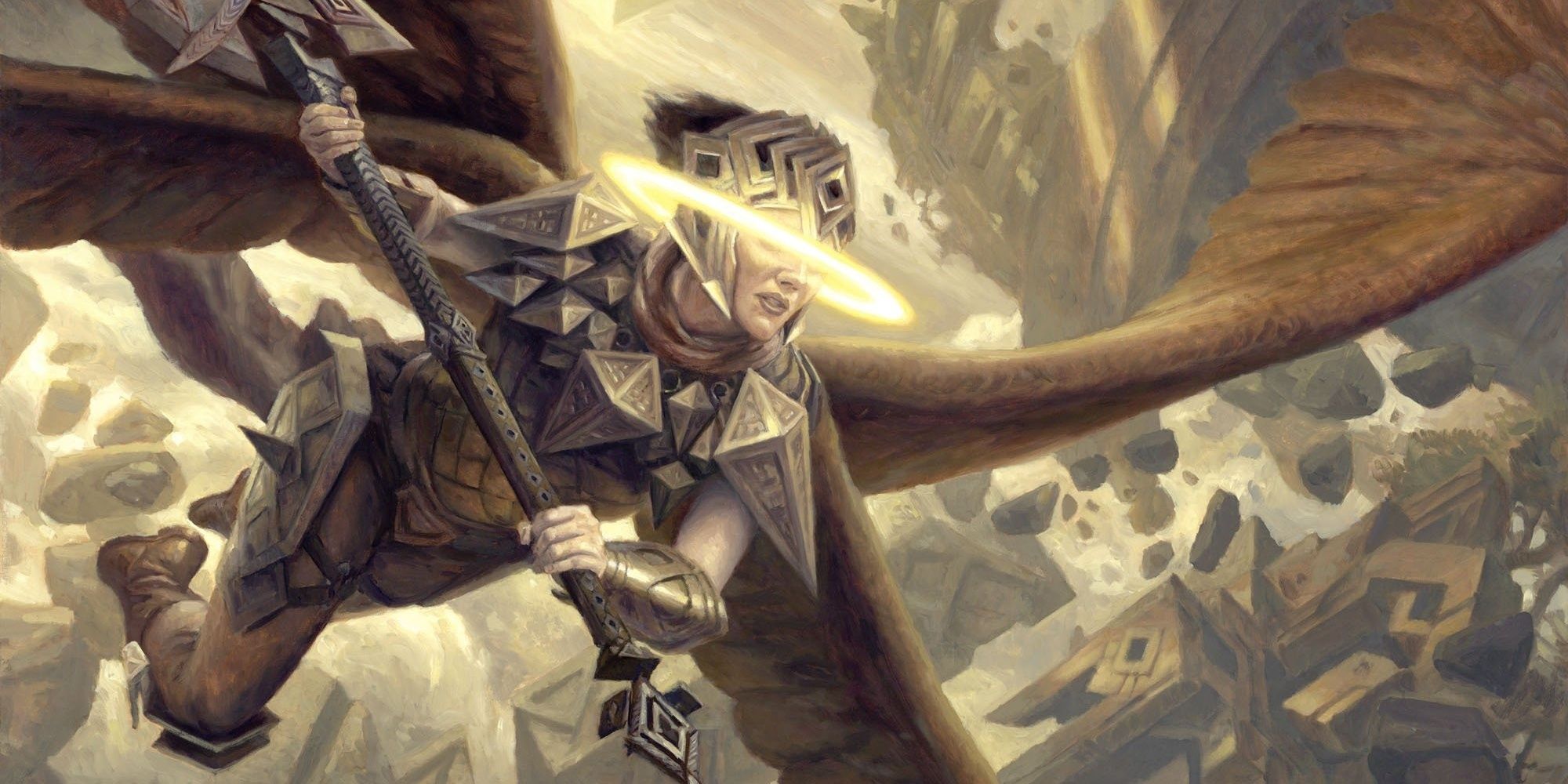
Magic: The Gathering's newest product is Time Spiral Remastered, and it's a throwback to the 2006-7 Time Spiral block. Unlike that block, however, Time Spiral Remastered is a Limited-only product, being designed for advanced sessions of booster draft Limited. There are all kinds of ways to break down and analyze this set, and that includes color.
Much like the original Time Spiral block, this set is quite complex, but any player can make sense of a set by breaking it down and reviewing what mechanics, creature types and strategies the five colors are using. This makes it much easier to choose one, two or three colors for draft and make a cohesive and powerful deck. Here what each color in Time Spiral Remastered can do.
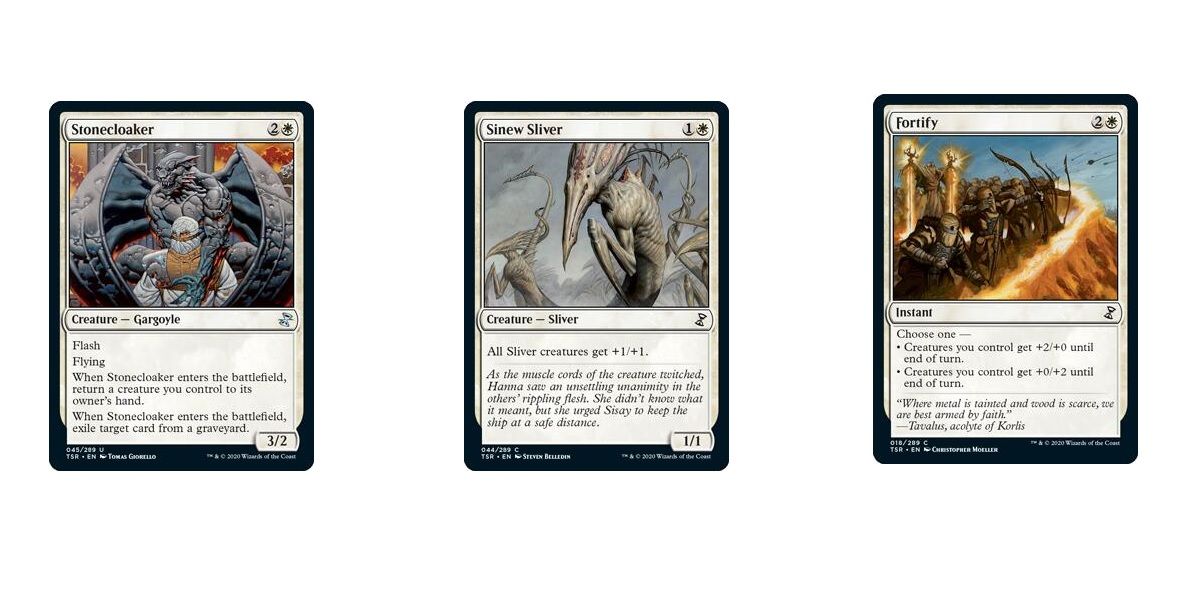
In Time Spiral Remastered, white mana focuses on flickering, bouncing and ETB effects in a white-blue archetype, but that's certainly not all it can do. Many of white's creatures have notable ETB effects, including the timeshifted cards. Thraben Inspector, returning from Shadows Over Innistrad, can make a Clue token for cheap, then sacrifice that Clue to draw a card. White mana desperately needs card draw like that, and the white cards of Time Spiral Remastered can easily flicker Thraben Inspector or bounce it to the hand to be cast again, making more Clues to play with.
Stonehorn Dignitary can negate the opponent's combat step, and Angel of Salvation is a 5/5 flier that can prevent damage when it enters the battlefield, another fine payoff for flickering. Creatures and spells such as Flickerwisp, Restoration Angel, Momentary Blink and Whitemane Lion can all flicker or bounce creatures, among other cards. A player looking to draft white should definitely pay attention to ETB effects and bounce effects.
White mana also has a stake in the Naya Slivers tribal archetype, contributing a few notable Slivers to that deck such as Sinew Sliver, Lymph Sliver and Watcher Sliver. As far as tribes go, white mana can also make a decent Rebels archetype, especially when combined with black mana.
White mana can also go wide, with or without the use of tokens, and cards such as Intangible Virtue and Fortify definitely reward such strategies. Lingering Souls can make some 1/1 flying Spirits and flash back if black mana is available too. Lastly, white mana can be splashed into the black-green Fungus/Saprolings aristocrats deck, with Pallid Mycoderm and Mycologist benefitting all Fungus. Fortify and Intangible Virtue can also augment this deck, since it runs many Saproling tokens.
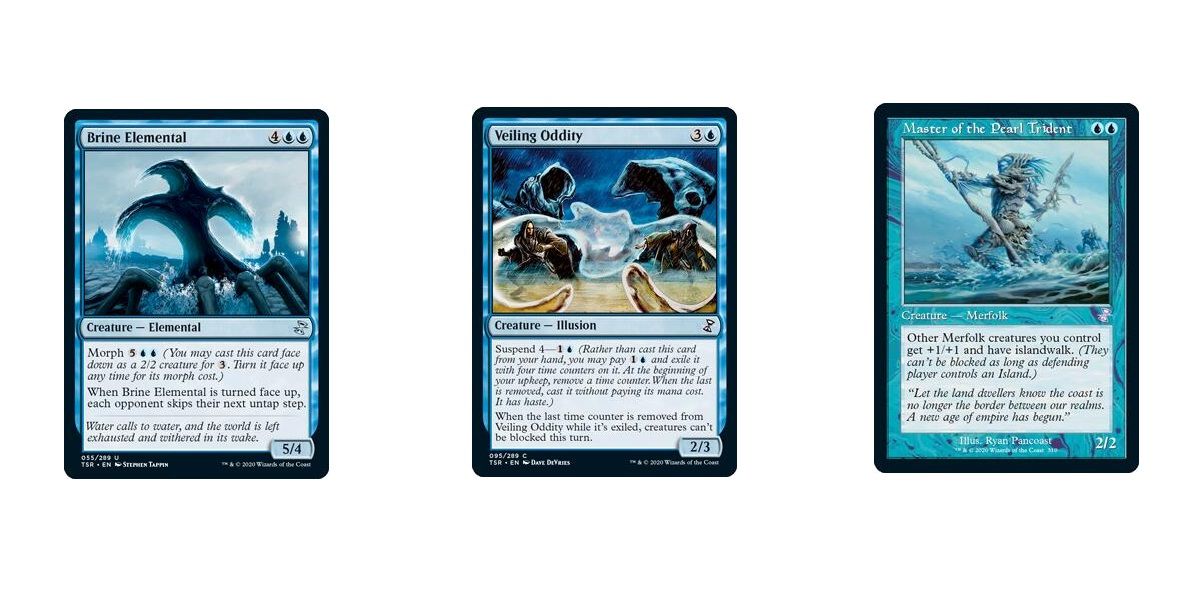
The blue cards of Time Spiral Remastered involve many of this set's trickiest mechanics and keywords, from morph to flashback and suspend. This may make blue difficult to draft, but the payoff can be huge. The flicker deck is a good start. When partnered with white mana, these blue cards can squeeze a lot of value from the deck's cards, since creatures will keep leaving and re-entering the battlefield at the last second to re-use ETB effects and dodge lethal damage or removal effects.
Riftwing Cloudskate is a 2/2 flier with suspend, and when it hits the battlefield, it will return another creature to its controller's hand. This can be used on Thraben Inspector, for example, to get another Clue token for cheap, or this effect can be used on an opponent's creature for a solid tempo play. Cryptic Annelid can be flickered to scry a few times, and Venser, Shaper Savant can be flickered to return spells or permanents to their owners' hands at instant speed, tripping up the opponent. Mulldrifter, meanwhile, can be flickered to draw two cards.
Blue mana shines brightest in the blue-red suspend deck, which is an archetype centered around time counters, echo and morph. The blue cards in this deck often have suspend or interact with time counters, such as Veiling Oddity, which can make all creatures unblockable when its time counters run out. Ancestral Vision will draw three card after being suspended, and Errant Ephemeron is a 4/4 flying beater with suspend. Timebender, meanwhile, is a blue morph creature that can flip face up to add or remove time counters from a permanent or a suspended card, allowing friendly suspended cards to be cast two turns earlier -- or delay the opponent's own suspend cards.
Blue mana has a minor Merfolk theme to it, with the timeshifted Master of the Pearl Trident being a must-have for this deck. Other Merfolk, such as True-Name Nemesis, Talrand, Coral Trickster, Riptide Pilferer and any number of Shapeshifters can round out this deck. Or, Merfolk can be added to some other deck to add a tribal plan B. However, there might not be enough good Merfolk to make a tribal-only deck like this.
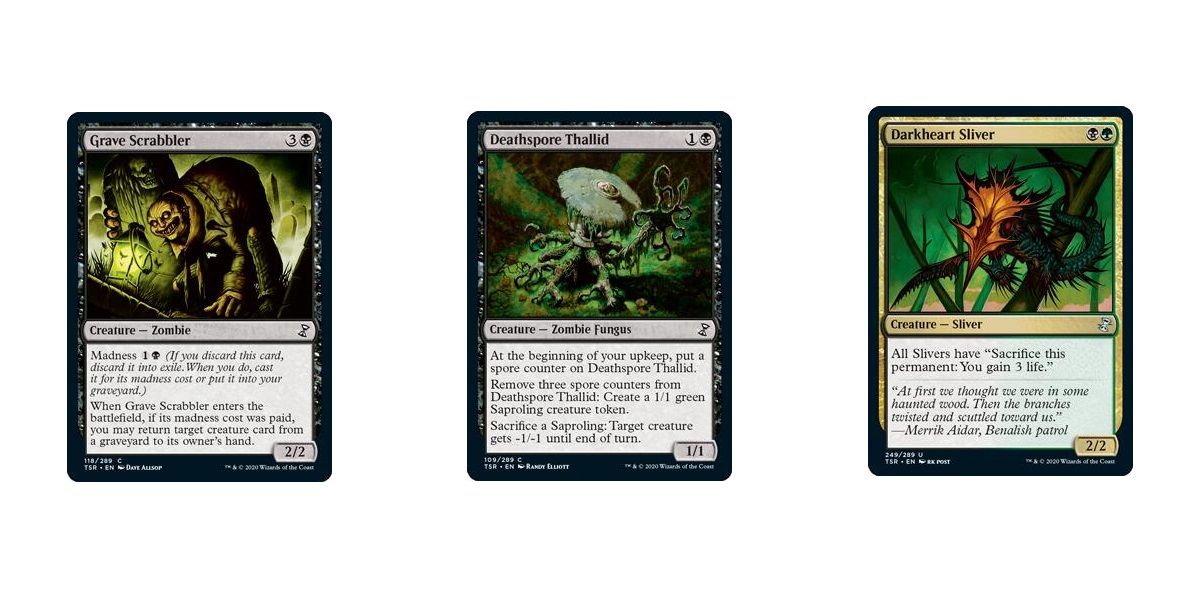
Black mana is strongest in Time Spiral Remastered when it partners with red to form a discard-based strategy, focusing on discarding cards to pay costs. But these discarded cards aren't going to waste; many of them have madness or flashback, ensuring that they can be useful while being pitched to the graveyard. Black cards like Deepcavern Imp, Urborg Syphon-Mage, Ridged Kusite and Trespasser il-Vec can all discard cards to enable their own effects. Once these cards are discarded, the player can make further use of them in other ways.
Any card with madness can be cast for its madness cost once it's being discarded for any reason, such as Grave Scrabbler. In fact, Grave Scrabbler is stronger when its madness cost is paid. Flashback spells like Strangling Soot can be cast again from the graveyard, whether they were once cast or discarded for some reason. Eventually, the player may have no cards in hand, and if so, the black creature Cutthroat il-Dal will gain shadow to make it far more evasive.
Additionally, black mana can contribute to the Fungus aristocrats deck with Deathspore Thallid, a little Zombie Fungus that makes Saproling tokens and can sacrifice them to weaken enemy creatures and kill them off. Black mana is necessary to help cast the legendary Fungus creature Slimefoot, the Stowaway, and black mana also contributes Dread Return to this deck. It can revive a creature, and the flashback cost is paid via sacrificing three creatures rather than mana, a cost that's easy to pay in an aristocrats deck.
Black mana contributes a few creatures to the Naya Slivers archetype as a splash color. If black mana is splashed in, then Darkheart Sliver can be cast, which can eat up redundant or doomed Slivers to gain three life. It's a great way to race the opponent's life total. Or, the player can use Necrotic Sliver, a white-black Sliver that allows any Sliver to pay {3} and sacrifice itself to destroy any permanent.
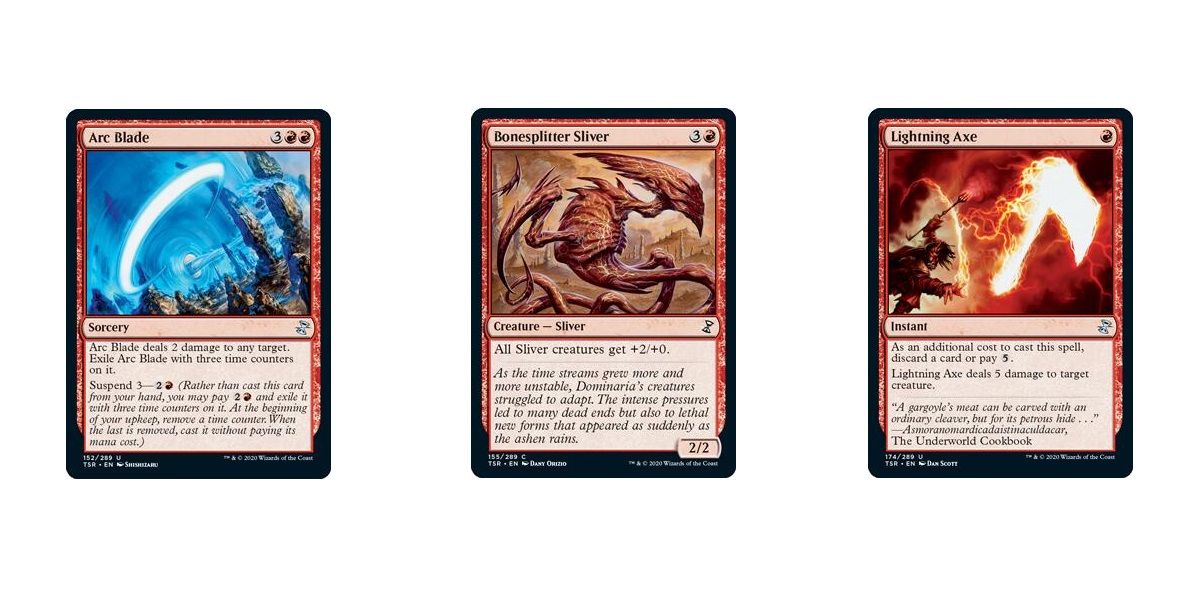
Time Spiral Remastered's red cards can be used in many different ways, starting with the suspend-based deck when partnered with blue. Just like blue, red has a lot of suspend cards, including burn spells like Arc Blade and Shivan Meteor. Red also offers two creatures that can interact with time counters: Shivan Sand-Mage and Rift Elemental, which can make it easy to accelerate suspended spells and cast them much sooner. Rift Elemental gets +2/+0 each time it "eats" a time counter, in fact, making it a fine attacker as well.
Some decent red creatures also have suspend, such as Greater Gargadon and Keldon Halberdier. Some red creatures also have echo, meaning they are very strong up front but require another payment on the next upkeep to avoid being sacrificed. However, some of these creatures offer benefits when they die, such as Mogg War Marshal, so declining to pay for echo isn't always a loss.
Red mana is vital for the Sliver deck, along with green and white mana. Red contributes Bonesplitter Sliver to grant +2/+0 to all Slivers, and the massive Fury Sliver is a 3/3 that grants double strike to all Slivers, which can quickly end games. Battering Sliver will give trample to all Slivers, making it easier to push damage. Lastly, red mana contributes to the black-red discard deck, with spells such as Lightning Axe, Conflagrate, Jaya Ballard and Exquisite Firecraft playing well into this archetype's strategy. Creatures such as Henchfiend of Ukor, Firemaw Kavu, Storm Entity and Gathan Raiders can also help.
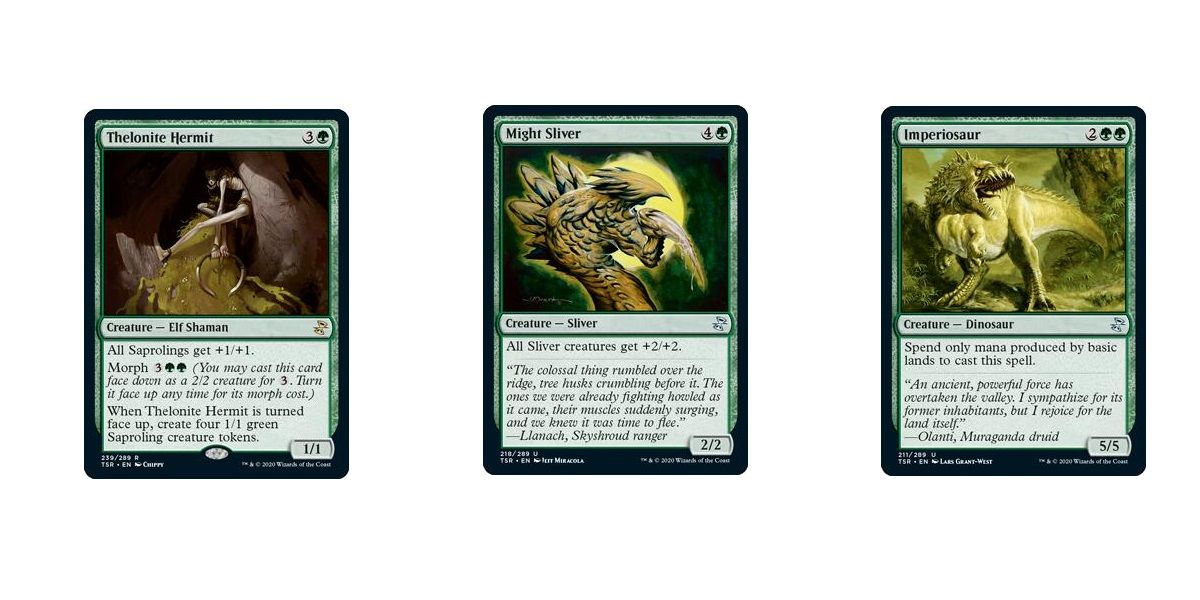
Green mana is the bedrock of the Fungus/Saprolings aristocrats deck, and a few Elves join the party too. Thelonite Hermit boosts Saprolings into 2/2 attackers as a fine plan B, When it's morphed, Thelonite Hermit will make a squad of four Saprolings ready for combat. There's also Thelon of Havenwood, a legendary Elf Druid that gives other Fungi +1/+1 for each spore counter on them, and it can pay BG and exile a Fungus from the graveyard to grant a spore counter on each friendly Fungus. Green Fungus creatures such as Sporesower Thallid, Utopia Mycon, Sporoloth Ancient and Thallid Shell-Dweller help complete this deck's army.
Green mana is the third major color of the Naya Slivers deck, and Might Sliver can quickly make its fellow Slivers far too big and tough for the opponent to handle, while the tiny Gemhide Sliver allows Slivers to tap for any color of mana, making it easy to splash blue and/or black Slivers into the deck. Fungus Sliver, meanwhile, slowly but surely grants +1/+1 counters to other Slivers as they are dealt damage.
Meanwhile, green mana can contribute powerful combat creatures to a deck that doesn't conform to a particular archetype, or to fill up the last few slots in a Slivers or Fungus deck. Imperiosaur is a wonderfully efficient 5/5 beater if enough basic lands are on hand (and they should be), and the notorious Tarmogoyf will prove itself once again in Limited. Green mana also contributes Durkwood Baloth, a 5/5 beater with suspend, and Kavu Primarch, which happens to have kicker to become even bigger via +1/+1 counters.
0 Comments